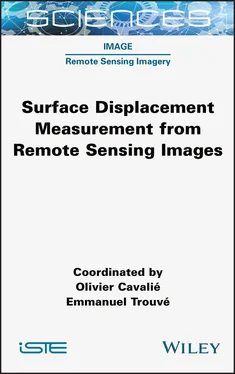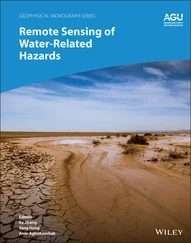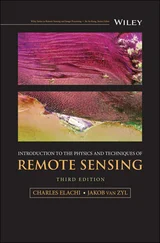Revisit: This corresponds to the time taken for a satellite to revisit a given geographical location on the Earth. It depends on the satellite orbit (altitude, inclination, etc.) and agility.
Repeat cycle: This key parameter expresses the number of days separating two data takes under the same orbital point of view, which can be equal to or higher than the revisit. At the beginning of the mission, in relation to the sensor field of view or swath, we must establish a total number of orbits Ntot and also choose the number of days in the cycle Dcycle . Then, we have the following relationship:
[1.1] 
where [14(or 15) + p/Dcycle ] is the number of orbit revolutions in one day. The orbit duration is about 100 min as the orbit altitudes are in the range of 400–900 km: when under 96 min, there will be at least 15 orbits/day. p is an integer chosen with a close relationship to Dcycle .
It is possible to change the repeat cycle during a mission, which means a change of altitude for the satellite. For example, ERS-1, with a change of altitude of less than 6 km, had a Dcycle that changed from 35 to 3 days. With a constellation where all satellites have the same orbit (but are phased differently), for example, with SPOT, ERS, CSK, Sentinel and TerraSAR-X/TanDEM-X/PAZ constellations, it is possible to combine images from the different satellites and hence reduce the time interval between data takes while keeping the same orbital point of view, called the “repeat time”.
Table 1.1. Main orbital parameters for some sun-synchronous SAR missions
| Satellite |
Local hour |
Entire rev. |
p |
Dcycle (days) |
Ntot |
Altitude (km) |
| ERS-1, ERS-2 routine |
22:30 |
14 |
11 |
35 |
501 |
785 |
| ERS-1 phases A, B, D |
22:30 |
14 |
1 |
3 |
43 |
775 |
| Envisat |
22:30 |
14 |
11 |
35 |
501 |
785 |
| Envisat end of life |
22:30 |
14 |
11 |
30 |
431 |
783 |
| Radarsat-1,2 |
18:00 |
14 |
7 |
24 |
343 |
798 |
| JERS-1 |
22:30 |
14 |
43 |
44 |
659 |
568 |
| ALOS |
22:30 |
14 |
27 |
46 |
671 |
692 |
| TerraSAR-X, TanDEM-X, PAZ |
18:00 |
15 |
2 |
11 |
167 |
515 |
| CSK, CSG |
6:00 |
14 |
13 |
16 |
237 |
620 |
| Sentinel-1A/B |
18:00 |
14 |
7 |
12 |
175 |
693 |
| Radarsat CM |
18:00 |
14 |
11 |
12 |
179 |
593 |
| ALOS-2 |
18:00 |
14 |
3 |
14 |
199 |
628 |
Table 1.2. Main orbital parameters for some sun-synchronous optical missions
| Satellite |
Local hour |
Ascending/descending |
Period of orbit (min) |
Dcycle (days) |
Altitude (km) |
| Cartosat-2A/2B |
9:32 |
D |
97.4 |
5 |
635 |
| Landsat 8 |
10:00 |
D |
98.8 |
28 |
705 |
| SPOT-7 |
10:30 |
D |
98.8 |
26 |
694 |
| Sentinel-2A/2B |
10:30 |
D |
100.6 |
10 |
786 |
| Kompsat-3A |
10:50 |
A |
95.2 |
28 |
528 |
| Co3D |
11:00 |
- |
94.6 |
- |
502 |
| WorldView-1 |
13:30 |
D |
94.6 |
14 |
496 |
| Eros B |
14:00 |
D |
94.8 |
4 |
520 |
Common parameters for optical missions: For the optical missions, the same orbital parameters are key elements for the mission. The orbits are in general sun-synchronous. The local hour has a direct impact on the viewed scenes. There is a compromise between viewing a scene early in the morning in order to reduce atmospheric effects (water vapor) and near midday in order to reduce the length of shadows in the images. The local hour is in general chosen between 9:30 and 14:00.
The choice of the orbital altitude has an impact on the spatial resolution, as well as on the viewing angle of the terrestrial scenes if a high revisit rate is required. High-resolution satellites are, in general, agile and consequently relax the mission constraints. The altitude of low Earth orbit (LEO) satellites is, in general, chosen to be between 420 km, the altitude of the International Space Station (ISS), and 900 km. The final resolution of the disparity map used to derive elevation (see Chapter 2) or offset map used to derive displacement is directly linked to the initial image resolution. So, the spatial resolution of the pixels is one of the key parameters of an optical mission.
Non-sun-synchronous missions: The famous Shuttle Radar Topography Mission (SRTM) was phased, but not sun-synchronous. With an inclination of 57° at 233 km altitude, this mission produced a worldwide digital elevation model (DEM), but it was limited in latitude.
1.1.2. Parameters specific to SAR missions
This section addresses some parameters specific to SAR systems. Some important parameters, such as the range and azimuth ambiguity ratios, are not listed because they do not really affect phase or ground motion measurements.
Central frequency and bandwidth: In SAR remote sensing, frequency allocation is a key issue. The International Telecommunication Union Radiocommunication Sector (ITU-R) provides recommendations for remote sensing (ITU-R 2009), and particularly for active microwave sensors with regard to Radiocommunication Requirements (RR) Art. 5 ( Table 1.3).
Table 1.3. Allocated frequencies and bandwidths for active SAR civil sensors in space as mentioned by the ITU-R (2009)
| Allocated frequencies by RR Art. 5(MHz) |
Conventional letter |
ITU required bandwidth (MHz) |
| 432–438 |
P |
6 |
| 1,215–1,300 |
L |
20–85 |
| 3,100–3,300 |
S |
20–200 |
| 5,250–5,570 |
C |
20–320 |
| 8,550–8,650 |
X |
20–100 |
| 9,300–9,900 |
X |
20–600 |
There are concerns, however, about other ITU attributions that affect these frequencies, in particular in the C-band (wireless LAN, mobile phones) and L-band (radio location and radio navigation), according to the ITU-R (2010). Sometimes military radars are also active in such frequencies. Both can cause real interferences in image data and make them partly useless. Each frequency has its own properties, and all categories have either flown (L, S, C, X) or are being scheduled (P-band with Biomass).
We can note from Table 1.3that the highest bandwidth is available in the X-band: as a result of this point combined with the more compact antennas needed for such missions and the inferred cost reduction, many new satellites are aiming at the X-band. In the ITU WRC 2015 meeting, an extension to a 1,200-MHz bandwidth (9,200–10,400 MHz) was approved, but some countries have expressed reservations and stick to 9,300–9,900 MHz (ITU-R 2020). In addition, this table is not applicable everywhere: for instance, the P-band is not accepted over the United States for SAR civil sensors. SAR missions of the interest detailed in this chapter and associated frequency bands are listed in Figure 1.1.
Читать дальше













